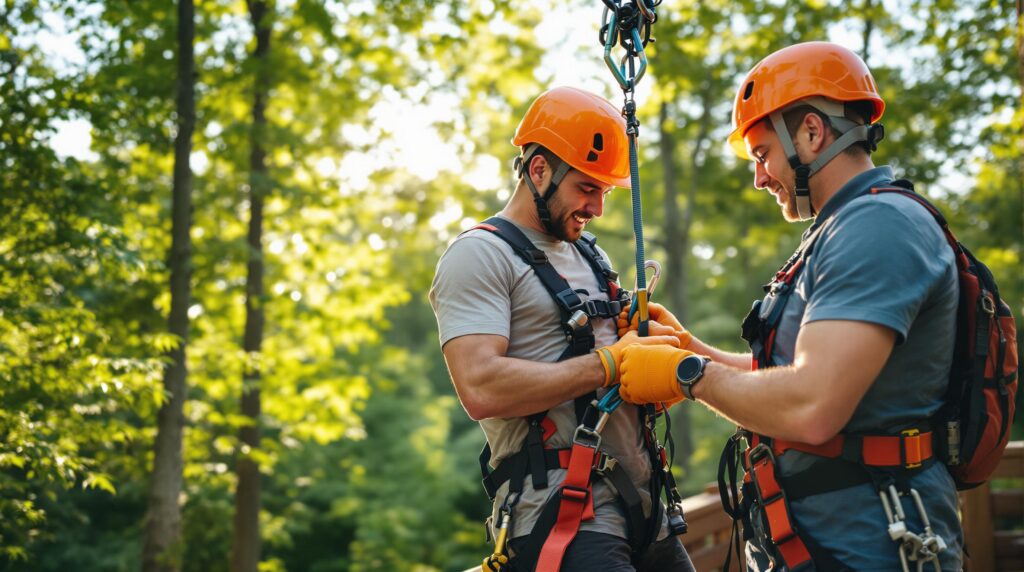Strap in or sit out—Bigfoot’s seven-line monster only rewards riders whose harness fits just right. A two-finger pinch here, a half-turn buckle there, and suddenly your 8-year-old is smiling instead of squirming, your GoPro clip is pushing 55 mph, and your scout troop is off the platform in record time.
• **Parents:** “Is this tight enough to keep Emma safe?”
• **Couples:** “Which strap setting shaves a second off our side-by-side race?”
• **Group Leaders & Nomads:** “How can we check 10 harnesses—and hit the trail—before the next Zoom call?”
Stick around for the fingertip fit test, age-and-weight cheat sheet (**70–270 lbs**, up to **58″ waists**), and three pro tweaks that turn a decent glide into a brag-worthy blast. Ready to lock, load, and launch?
Quick Takeaways
• Zip lines go 35–55 mph; a snug harness keeps you safe and fast
• Riders must be 6 years old, 70–270 lbs, and under a 58 in. waist
• Two-finger test: belt tight enough for just two fingers to fit
• Fast fit steps: tighten waist, leg loops high, snug shoulders, triple check buckles
• Loose straps = spinning and slowing down; tight straps = straight and speedy
• Wear close-fitting clothes and light shoes to cut wind drag
• Braids or tuck long hair; side cams or hoodie strings can slow you
• Best times: weekday mornings or light tailwind days for extra speed
• Warm up 5 minutes (leg swings, squats) for better body position
• Guides always inspect gear, but practice these steps to launch quicker.
60-Second Reality Check: How Fast Can We Fly?
Bigfoot Zipline Tours strings seven separate lines across more than 6,000 feet of forest canopy, a layout that sends riders gliding at roughly 35–50 mph. The highlight reel includes the 1,397-foot “Me Tarzan, You Jane” line and the 120-foot-high “Zipzilla,” which can crack 55 mph with the right tailwind. The numbers thrill, but speed hinges on one truth: a harness that hugs every curve without pinching circulation.
Dial in your fit and the payoff is instant—smoother acceleration, steadier posture, and fewer mid-air wiggles that steal momentum. Guides confirm it daily: guests who click through all three buckle checks reach the bottom faster and seldom need a retrieval rope. For extra trivia to hype the group, skim the official Bigfoot details page or the short Zipzilla preview before you roll into the parking lot.
First Things First: Are We Even Cleared to Ride?
Before any straps tighten, Bigfoot staff re-weigh and measure every guest. The permitted window is 70–270 pounds with a waist no wider than 58 inches. Riders must also be at least six years old, giving younger adventurers enough torso length for a secure chest strap.
Planning a family reunion or scout outing? Email the roster 48 hours ahead, noting ages, estimated weights, and any XL requests. Guides can pre-stage labeled harnesses, shaving minutes off check-in and preventing the dreaded wait-around shuffle—especially in kids eager to brag about Line 4.
Why Harness Fit Dictates Both Safety and Speed
A loose waist belt lets the torso rotate, turning riders sideways and inflating their profile like a windsock. The extra drag can bleed three or four miles per hour—enough to stall on the slower lines and force a hand-over-hand rescue. Worse, rotation shifts weight away from the main carabiner, increasing stress on secondary webbing.
By contrast, a snug, balanced rig keeps hips centered under the pulley. The result is a bullet-like posture: toes pointed, shoulders narrow, airflow clean from helmet to heel. Guides can also reel you in faster if the auto-brake stops short because the retrieval line clips cleanly to a stable harness, not a spinning kite.
The Four-Step Fast-Fit Method
Forget frantic tugging at the last second. Spend two focused minutes on the platform, and you’ll glide truer and land smoother than the rider who rushed through the checklist. These foundational moves are the same ones guides master during certification, so mirror them and watch your confidence soar.
A second pass eliminates hidden twists, half-latched buckles, and loose tails that flap like drag chutes. When every strap sits flush, airflow stays tight around the body, translating gravity into pure forward thrust rather than sideways wobble. Now you’re ready for the precision sequence below.
1. **Waist Belt** – Center the buckle over your navel. Pull until only two fingertips fit between belt and belly.
2. **Leg Loops** – Slide each loop high on the thigh, not down by the knee. Stand: a flat hand fits; sit: the loop cinches.
3. **Shoulder Straps** – Remove slack until webbing kisses the collarbone without compressing your chest.
4. **Triple Check** – (a) Tug every buckle to confirm it’s doubled back, (b) do a short hang test, (c) get the guide’s visual sign-off. Ninety seconds here saves five minutes of dangling later.
Fine-Tuning for Your Adventure Style
Every group shows up with different goals—some crave all-out speed, others just want a stress-free family memory. Small tweaks tailor the harness to those priorities without breaking Bigfoot’s safety playbook. Consider the tips below a portable coach whispering in your ear on the launch deck.
Adjusting for body type or competition can reclaim seconds and smiles. A tighter core strap steadies deep-breathing kids while a helmet-mounted GoPro keeps couples’ footage rock-solid. Leaders juggling big headcounts will appreciate color-coding and mirror drills for slashing prep time.
• **Parents:** Add an extra inch of shoulder tension for lightweights under 100 lbs to keep them upright.
• **Couples:** Cinch the waist one notch tighter, center GoPros on top of helmets, and challenge each other on Line 4’s twin cables.
• **Group Leaders:** Use the mirror method—everyone copies your buckle moves in sync; color-code sizes to slash fitting time.
• **Digital Nomads:** Book the 9 a.m. slot, pre-fit early, stash harnesses, and still make that noon video call.
Dress and Gear That Slice Through Drag
Clothing works like the paint job on a race car—slick surfaces slice through air, and dangling bits slow everything down. Swap billowy cotton for stretchy synthetics that cling but breathe, and the airflow hugs your outline instead of inflating it. Light trail shoes trump heavy boots because they keep your toes pointed and ankles relaxed.
Hair and accessories matter just as much. Braid or tuck long hair; loose strands whip into the pulley’s breeze and act like small parachutes. Side-mounted cams or dangling hoodie pulls offset your center of gravity and skim miles per hour, so stash or center every extra before the gate clicks shut.
Five-Minute Warm-Up for a Streamlined Ride
A quick dynamic warm-up primes joints and muscles for that toes-pointed, knees-soft pose. Ten leg swings per side, a dozen hip circles, and ten squats grease the hinges that control mid-air posture. Add shoulder rolls so the harness sits naturally instead of digging while you glide.
Mental rehearsal deserves equal billing. Close your eyes, breathe deep, and picture your form slicing the tree line—athletes call this “priming the neural pathway,” and it works. A calm, rehearsed mind cues the body to lock in that aerodynamic silhouette the moment you step off the ledge.
Timing and Weather Hacks
Not all launch windows are created equal. Cooler early-day temps keep bodies fresh, but a late-morning sun thins the air, sometimes yielding faster runs on Lines 5–7. Toss in a mild 5–10 mph tailwind, and you’ve earned a gravity bonus without lifting a finger.
Fresh rain can also lubricate pulley bearings, turning the glide buttery-smooth, while off-peak weekdays reduce platform waits so your muscles never cool between lines. Watch the forecast, pick your slot, and you’ll squeeze every drop of speed from the cables.
Fine-tune your harness, fly the forest canopy, then coast straight into a night of s’mores and story-swapping under Bonanza’s pines. Our convenient, family-friendly resort puts you minutes from Bigfoot Zipline Tours and miles closer to the next day’s adventures—whether that’s waterpark waves or another round of high-speed glides. Lock in your tour, reserve your campsite in the same breath, and watch the whole getaway fall neatly into place. Ready to pair sky-high thrills with North Woods chills? Book your Bonanza stay now and let the memory-making begin.
Frequently Asked Questions
Q: What’s the safest harness fit for my 8-year-old?
A: Center the waistbelt at belly-button height, tighten until only two fingertips slide under the webbing, snug leg loops high on the thighs, then ask the guide for the mandatory visual check; this combo keeps young riders upright, comfortable, and well inside Bigfoot’s 70-270 lb safety window.
Q: Will a guide really double-check every buckle before launch?
A: Yes—Bigfoot’s policy requires staff to confirm the three critical points (waist, legs, shoulder) on every guest, every line, so you’ll never step off the platform without a fresh set of professional eyes.
Q: How fast will I actually go if my harness is dialed in?
A: Most guests cruise between 35 and 50 mph, and on the 1,397-foot “Zipzilla” line a tight, well-balanced rig plus a mild tailwind can push heavier adults past 55 mph.
Q: What are the size and weight limits for the gear?
A: Riders must weigh 70–270 lbs and fit a waist no larger than 58 inches; kids also need to be at least six years old so the shoulder straps sit correctly on the torso.
Q: How long does the whole seven-line tour take from check-in to finish?
A: Plan on about two hours total—15 minutes for weigh-in and fitting, 90 minutes gliding line to line, and a few extra minutes for group photos and gear return.
Q: Which single adjustment gives the biggest speed boost?
A: Keeping the waistbelt high and tight on the hip bones prevents mid-air spinning, slices wind resistance, and usually adds three to four extra miles per hour on the longer lines.
Q: Can I mount a GoPro on my helmet or chest?
A: Helmet mounts are allowed and give the steadiest footage; chest rigs are discouraged because they can shift the harness center of gravity and are more likely to be denied by the guide during the pre-flight check.
Q: How many guides will be assigned to my scout troop of 18 kids?
A: Bigfoot staffs one certified guide for every eight riders, so your group would have at least three guides plus a lead, ensuring quick harness inspections and smooth platform flow.
Q: Are XL and youth harnesses available if our reunion group spans sizes?
A: Absolutely—Bigfoot stocks color-coded small, medium, large, and XL rigs, and you can list size requests when you email the roster 48 hours before arrival to have everything pre-staged.
Q: When are the quietest hours for digital nomads trying to zip between meetings?
A: The 9–11 a.m. weekday slot typically sees the lightest crowds, letting you check in, fly all seven lines, and be back on Wi-Fi at Bonanza before lunchtime.
Q: Is there a night-zip or sunset option for thrill-seeking couples?
A: From late June through August, Friday and Saturday evening tours depart around 7 p.m.; spots are limited and sell out weeks ahead, so book early if you want those golden-hour skyline shots.
Q: Can two of us race side-by-side on any of the lines?
A: Yes—the twin cables on Lines 3 and 4 run parallel and equal in length, so just tell the guide you’d like to pair up and they’ll stage you together for a head-to-head dash.
Q: Do combo discounts exist if we camp at Bonanza and zip the same weekend?
A: Check the Bonanza booking page for the current BONANZAZIP promo; when active, entering the code at both checkouts shaves 10 % off your campsite and $5 per zipline ticket.
Q: What’s the quickest way to get my whole group through harness fitting?
A: Arrive with liability forms printed, line riders shoulder-to-shoulder for a mirror-style demo, and have everyone perform the two-finger belt test simultaneously; guides say this shaves nearly 10 minutes off pre-flight time for groups of ten or more.

